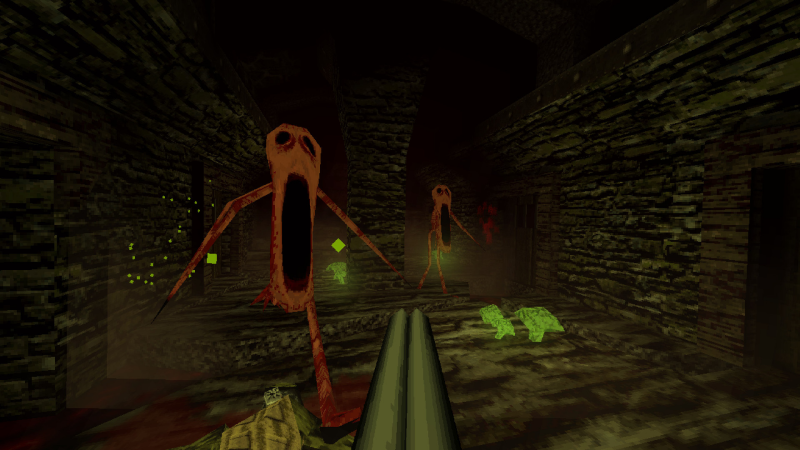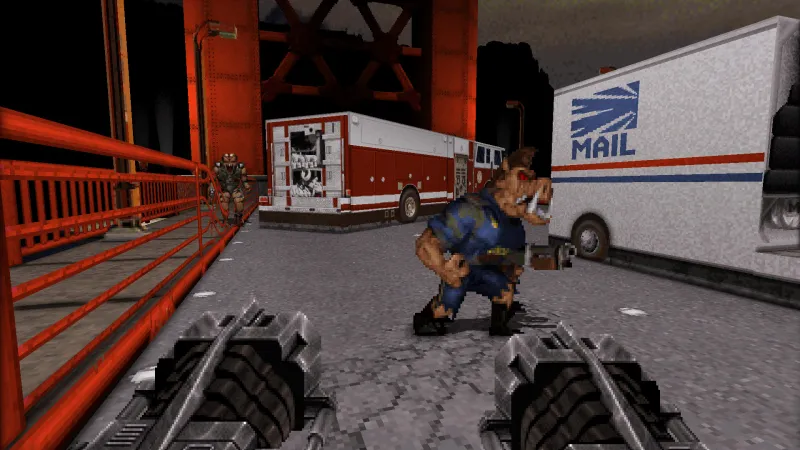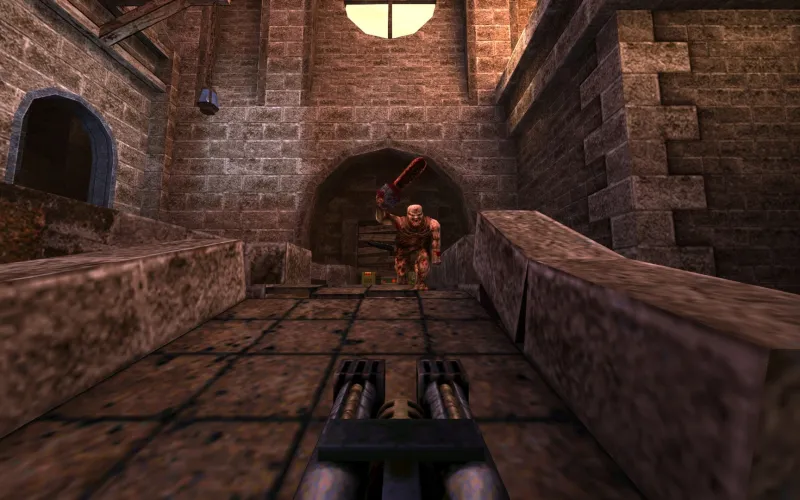
You are a banshee of speed, a spark crawling its way up a fuse, a disaster waiting to happen. Until –
A scarecrow makes the mistake of turning into a man right before you, a shotgun-toting farmer with the barrel pointed at your face. You greet him with your own shotgun, double-barreled, finger on the trigger.
You eclipse him in a bear hug of bullets and sound. Above you, the sky – already the hue of a bloodhound’s fever dream – is somehow even redder. One moment later, and you’re already gone.
This is Dusk, one of a handful of recent games harkening back to the Doom and Quake era and the invention of the FPS genre itself. Over the past few years, “boomer shooters” like Dusk, Amid Evil, and Ultrakill have awakened a hunger long thought dormant, and publisher New Blood Interactive is on a mission to ensure we remain well-fed.
Knee-Deep In The Dead
In 1993, a shotgun blast thundered throughout millions of American bedrooms. It echoed across college dormitories and office cubicles, casting firework bursts of light onto the faces of whoever witnessed it.
The blast was so powerful it survived a journey across the globe and back, withstanding entire generations without fading away. It afflicted any who heard it with a strange sickness: The fanatical desire to bully digital devils into piles of bloody gibs (i.e., pulpy chunks of gore).
In short, they discovered Doom.
 The original Doom, released in 1993
The original Doom, released in 1993
In Doom, the player is a space marine barreling through military bases and eventually into Hell itself, laying waste to rooms of demon invaders. It's still revered as a towering monument to video game violence.
Id Software, Doom’s developer, had found earlier success with 1992's Wolfenstein 3D, a game that synthesized 3D graphics with fast, first-person action gameplay. Together with Doom, they helped shape the FPS genre and kickstart a PC gaming revolution.
Not only is Doom’s engine the basis for countless user-made WADs – Doom lingo for “mods” – but it also serves as the foundation for Raven Software’s Heretic (1994) and Hexen (1995). These games swap Doom’s sci-fi for dark fantasy, arming the player with flails and scepters instead of guns.
Such was the era of the “Doom clone.” The studio Apogee – now 3D Realms – followed up Rise of the Triad: Dark War (1995) with Duke Nukem 3D (1996), a game now notorious for its hyperbolic “dudebro” humor. Other Doom clones include Star Wars: Dark Forces (1995), Blood (1997), and Shadow Warrior (1997).
 Duke Nukem 3D
Duke Nukem 3D
On a mechanical level, these games are united by high movement speeds, labyrinthine levels, and level “scores” measuring completion times and percentages (e.g., how many enemies or secrets the player found). Aesthetic similarities include slasher-movie bloodiness and animations that render enemies into supernovas of gibs.
After 1994’s Doom II, Id Software broke new ground again with Quake in 1996, introducing “true 3D” levels with vertical camera movements and the “deathmatch.” 1997's Quake II introduced animated cutscenes and more comprehensive lighting effects; dim hallways turned bullets into kamikaze fireflies.
For a moment in the ’90s, it felt like Doom clutched the very future in its claws. But over the next two decades, the FPS genre reinvented itself many times over to accommodate the trends of the growing industry. The era of the Doom clone faded away – until recently.
By the time New Blood released David Szymanski’s Dusk in 2018, it had been exactly 25 years since Doom first gripped the world with its fury. The same year, New Blood released Indefatigable’s Amid Evil. In both games, Doom and Quake are evident as influences from the moment you train your weapon on your first bloodthirsty freak.
But these games aren’t Doom clones: they are boomer shooters.
Dimension Of The Doomed
First, the obvious. Why “boomer shooter”? According to the dates above, most members of the original Doom clone audience would be Gen X’ers.
Szymanski says that the anachronism in calling themselves “boomers” was always part of the joke. “We're the out-of-touch boomer dad mowing our lawns, drinking Monster Energy, and talking about how awesome Quake was,” he says. Yet the term also alludes to the genuine longing that prompted developers like him to reevaluate the history of the FPS genre itself.
In Szymanski’s opinion, signs of the changing times were evident by the mid-2000s. “It's before stuff got really cutscene-heavy and ‘hand-holdy’ and stuff like that,” he says.
 Quake
Quake
Szymanski, who grew up in rural Pennsylvania in a house swallowed by trees, could only experience the genre’s evolution vicariously. In early adolescence, he’d cultivated a love for shooters after discovering Chasm: The Rift – a lesser-known shooter from the Quake days – on a shareware disc.
But the hardware in his family’s computer regularly failed to meet the requirements of then-modern games, which were becoming more demanding as graphics advanced. Instead, he frequented the local library to use its internet, gleaning as much information as possible about the latest FPS titles.
“2004 was a mini-golden age of FPSs,” Szymanski says. “Before stuff went the way of the linear cinematic shooter […] that was really when that formula was at its best.” That year marked the release of three landmark FPS titles: Halo 2, Half-Life 2, and Doom 3, each alluding to new futures for the genre.
Though he’d harbored a quiet longing to play Doom 3 himself, Szymanski was content to play the first Doom, the first Quake, and other ’90s shooters like Chasm, laying the foundation for his fascination with the era.
Icon Of Sin
Meanwhile, as the FPS genre continued shifting, so did the game industry. Dave Oshry, one of New Blood’s co-founders, witnessed this first-hand. “PC gaming was very dead for, like, 10 years,” Oshry says. “It was not the ’90s anymore.”
Id Software’s John Carmack once famously compared stories in games to stories in porn, arguing that narrative is unimportant in either context. History, however, proved him wrong.
For example, 2007’s Call of Duty 4: Modern Warfare represented a watershed moment. In addition to foretelling the industry’s fixation on militaristic settings, COD 4 contained the series’ most ambitious single-player campaign to date, shifting perspectives between characters of various backgrounds as they navigated a global nuclear conflict.
By the early 2010s, TV critics had begun using the term “prestige TV” to describe shows that were considered on par with film in artistry; soon, the idea of a “prestige game” emerged, too. 2013 alone had The Last of Us, Bioshock Infinite, and Grand Theft Auto V – big-budget epics rich with detail.
That same year, Oshry was one of the people at the helm of a project with much different aspirations. He’d joined a studio called Interceptor Entertainment – now Slipgate Ironworks – to direct a remake of Rise of the Triad.
The ROTT team included Leon Zawada and Simon Rance, childhood friends who later formed the studio Indefatigable. Though this was their first professional experience in game development, the two shared a storied history of designing WADs together, swapping turns at Rance’s PC as children.
 Dusk
Dusk
“My uncle had a copy of Doom II and used to make maps for it – specifically, multiplayer maps,” Zawada says. “It was such a revelation that you could make these 3D worlds.”
After ROTT was released in 2013, Oshry, Zawada, and Rance each left Interceptor to pursue other projects. Empowered by their stint in a professional environment, Zawada and Rance began working on their own game. Though Doom and Quake were primary inspirations for level design and game feel, Heretic and Hexen influenced the game’s visual identity and arsenal of magic-infused weapons.
Oshry, on the other hand, founded New Blood with some friends. They spent a few years developing VR games before pivoting into indie publishing, but Oshry still hadn’t felt that they’d found their voice.
Suddenly, in 2016, Oshry got a Twitter DM that changed everything. “This random guy’s like, ‘Hey, do you want to check out my game?’” Oshry recalls.
